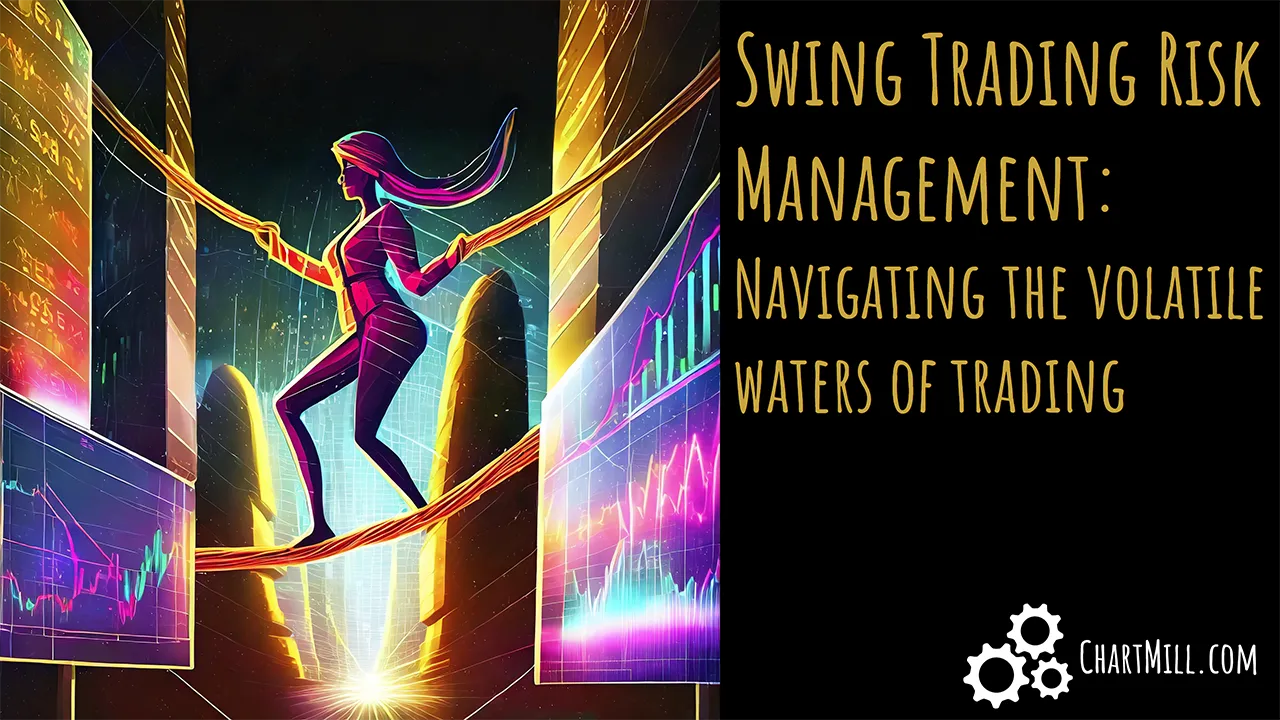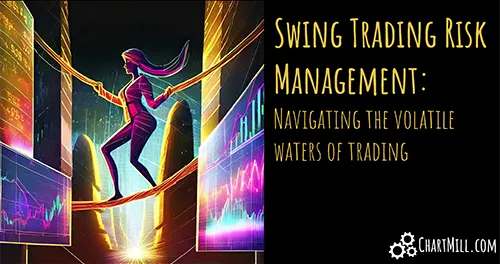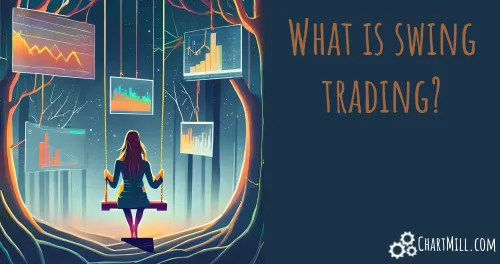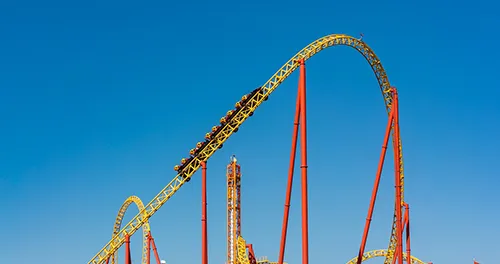Swing Trading Risk Management: Navigating the volatile waters of trading
By Kristoff De Turck - reviewed by Aldwin Keppens
~ 6 minutes read - Last update: Apr 19, 2024

Swing trading is one of the most popular trading strategies among active investors. It is less stressful and time-consuming than day trading but a lot more active than the traditional buy-and-hold approach.
The ability to profit from both bullish and bearish trends and the fact that the capital is only tied up in the stock for a relatively short time are just a few of the advantages.
Swing traders thereby have to rely on stocks that move fast and hard to take full advantage of the short time horizon in which they operate. However, that degree of volatility does create increased risk. Fast excessive price movements can quickly generate profits, but equally losses!
In this blog post, we highlight some decent swing trading risk management practices to minimize your risk, so that your trading capital enjoys maximum protection.
The Importance of Swing Trading Risk Management
To succeed in this type of trading, you need a comprehensive risk management strategy. To be clear, this is not about avoiding risks altogether; it's about understanding and mitigating them effectively.
By implementing a few simple principles, you can significantly reduce the risk.
1. Position Sizing
Usually, investors have a good idea of what they want to buy and what price they are willing to pay for it. The number of shares that will be bought is less thought about while it is just a crucial factor in controlling your risk.
Investing an excessive amount of your capital in one stock is one of the most common mistakes, especially among less experienced investors.
Suppose you have $20,000 available to invest. If you use $10,000 to invest in one stock and the stock suddenly opens 50% lower (for example, because the quarterly results are much worse than expected...) then this has a huge effect on your portfolio because suddenly only $5000 of that $10,000 invested is all that remains. This is a whopping ¼ of the capital you started with. In other words, the value of your total portfolio has dropped by 25% because of the bad news about that one stock!
Therefore, always make sure that your initial investment never exceeds a maximum of 10% of your total initial capital. If the stock then opens 50% lower it will only have a 5% impact on your portfolio. Still a significant loss but not a disaster.
2. Setting Stop-Loss Orders
One of the fundamental principles of risk management is setting stop-loss orders. A stop-loss order is an order placed with a broker to buy or sell once the stock reaches a certain price. It's your safety net, ensuring you don't lose more than you can afford.
Do not use stop limit orders but only market stop loss orders.
Why? This is all about protecting your investment assets. If your stop loss is hit, the position should be closed as soon as possible. When using a limit, there is a danger that the price opens below your set stop loss (making your stop loss inactive) and the price suddenly plunges down many more percent. Your loss will quickly be a lot larger than what you initially intended.
3. Risk%
Anyone who wants to become and remain structurally profitable as a swing trader in the long run will have to focus primarily on the size of the loss positions (which are inevitable, in any strategy).
Far too many traders focus on the size of the potential profit. Don't worry so much about the profit but keep an eye on your losers.
If you set a stop loss on each new position that would mean a 5% loss for your overall portfolio, after 4 consecutive losers you are looking at a drop of as much as 20%. And be warned, a series of consecutive losing positions is not at all exceptional. Even the most experienced traders have had periods where one position after another turns into a loss (sometimes up to 10 or more positions in a row). Especially when market sentiment suddenly turns, a reliable strategy may not perform as well for a while.
Trading less or even staying out of the market for a while is the best solution in that case but that does not take away the fact that you will first be faced with several consecutive negative trades. However, if you use a risk% of a maximum of 2% (this is the maximum loss on your total port if the initial stop loss is reached in one position) then after a sequence of 4 losing trades you are looking at a total loss of 8%. Again, not nice but fortunately not insurmountable.
4. Risk-Reward Ratio
A successful swing trader should always have a favorable risk-reward ratio. This means that the potential reward should outweigh the risk in every trade. Typically, a risk-reward ratio of 1:2 or 1:3 is recommended.
More precisely, if your investment capital is $20,000 and you are applying a maximum risk percentage of 1% to each new position (equivalent to a maximum loss of $200 on an individual position) then it is best to make sure that your average profit is at least $400 to $600.
Why not just at least $200 as well? A higher risk/reward gives the advantage that you can even have more losers than winners and remain profitable!
Suppose you have ten consecutive trades with the following result:
- Trade 1: +$400
- Trader 2: -$200
- Trade 3: -$200
- Trade 4: -$200
- Trade 5: +$400
- Trade 6: -$200
- Trade 7: +$400
- Trade 8: -$200
- Trade 9: -$200
- Trade 10 : +$400
Losing positions: 6 *(-$200) = -$1200
Winning positions: 4 * (+$400) = +$1600
Thus, after ten trades you have a profit of $400 despite having closed 6 of the 10 positions with a loss.
Some Ohter Swing Trading Tips to Reduce Risk
Beware of undercapitalization
This is closely related to the point above about position sizing. It is obvious that if you trade with too small a trading capital, it becomes very difficult to make sure that no too large part of that capital is invested in one position.
Especially since in that case, the effect of costs (brokerage fees and any taxes) has an excessively large impact on the return of your portfolio.
A portfolio of only $5000 where you want to make sure that an individual position should only comprise 10% of that capital has the consequence that each position can only be $500. You will have to ask yourself whether that is sufficient when you factor in expenses. What is the minimum return you need to cover your costs?
Managing Emotions
All too easily we believe we can be very rational in our decisions, but in reality, this is hugely disappointing. Of course, there is no problem if the strategy is successful and we only experience a few loss positions from time to time.
It becomes a different story when we experience a series of losses where it seems like the strategy is no longer working. At that point the urge to want to adjust the strategy or even stop completely and try another strategy is tempting. Or, in the case of a profitable position, we suddenly start taking those profits off the table much faster... In the worst case, we even cancel the stop loss because, after the umpteenth loss, you are convinced that this time it will work out just fine...
The only thing you can do in that case is to distance yourself and stay out of the market for a while. Again, certain market conditions can (and will) cause your strategy to underperform.
But in that case, try to control your emotions and don't immediately start tweaking your strategy.
Stick to the Plan
A well-defined strategy in which you set the entry rules, stop loss and managing an open trade is your best option not to deviate from your strategy.
Such a plan gives you something to hold on to and it will make you less likely to change the rules if your strategy is temporarily not doing as well.
Plan the trade and trade the plan.
Use the ChartMill Stock Position Size Calculator
This is a helpful tool to determine your stop loss, risk% and position size, taking into account the amount of capital you have available to invest.
Read more about it in this article.
More on the Swing Trading Strategy
What is Swing Trading?
In this basic article, we will explore the exciting world of this specific approach and provide you with valuable insights into its strategies and techniques. Read more...
Best Indicators For Swing Trading Stocks | Enhance Your Swing Trading Setups.
In this article, we discuss some of the best indicators and patterns for swing trading in stocks. Using them will make your trading strategy a lot more consistent, allowing you to better control your emotions while trading. Read more...
Exploring The Best Moving Averages For Swing Trading Success
This type of trading relies heavily on technical analysis, traders employ various tools and indicators to make decisions regarding entry and exit points. One such tool that plays a crucial role in swing trading is the moving average. Read more...










